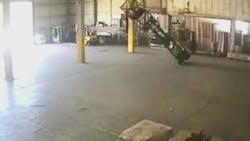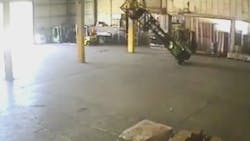Forklift Life Lesson #6: OSHA's Picky about How You Cage Workers
Fortune 500 companies are usually pretty smart about safety. So imagine the surprise of the Environment, Health and Safety (EHS) manager of one of them when, during an OSHA audit, the inspector accused him of having an illicit “Man cage.”
Slave labor? No, “man cage” is the term some apply to what its makers call a “fork-mountable work platform.” Industrial Trainer David Hoover also calls these things “necessary evils” because he knows whatever he calls them, companies will continue to use them—often improperly. What was the OSHA inspector’s beef with that EHS manager? Keep in mind, this work platform was brand new, had all the necessary safety stickers and labels on it, and the manager even documented the training he did for the users. What more did the inspector want?
“We want documented approval from the forklift manufacturer it’s used on, per our standard, 1910.178(a)(4),” he answered. Here’s what that provision states:
“Modifications and additions which affect capacity and safe operation shall not be performed by the customer or user without manufacturer’s prior written approval. Capacity, operation, and maintenance instruction plates, tags, or decals shall be changed accordingly.”
This was a canny EHS pro, and he still got trapped in a regulatory man cage. If he could be ignorant of such a requirement, imagine what Hoover finds in workplaces where they can’t spell EHS. These are the kinds of places that use wooden pallets as work platforms and forklifts to raise workers standing on them to any task that’s out of normal reach. He doesn’t see “man cages” as much better.
“They’re commonly used for overhead maintenance work like replacing light bulbs, doing sanitation, and even electrical work,” Hoover told me. “But with cages people get lazy and don’t attach them to the lift truck. And it would be rare for me to go into a place that has man cages and not find one defect. The chains that hold the cage on the truck to ensure it doesn’t fly off the forks while being used are often broken, or they’re insufficient to do the job. Newer ones do have a mechanism that locks the cage around the heel of the fork. In theory that’s a great idea, but in practice these cages get dragged around the floor and the locking mechanism gets bent easily and then it’s impossible to lock.”
But even properly attached work platforms are only as safe as the lift truck they’re attached to—and the operator at the controls. Hoover sent me a video showing the cardinal sin of those using forklift-mounted work platforms: Transporting somebody on one. You can see this video below and witness the consequences.
“Moving at a high rate of speed with the mast up is a bad idea with any forklift, even without a man cage,” Hoover says. “If you’re moving and turning, that’s a recipe for flipping the truck over.”
He recommends investing in an aerial work platform or a scissors lift if you want your people reaching for the ceiling. His reasoning? It’s more controllable, more flexible, and from a productivity standpoint, why would you want a forklift operator acting as a chauffeur for someone changing light bulbs?
I checked with a spokesman for one of the providers of fork-mountable work platforms, Vestil Manufacturing, and he agrees that improperly used, these can be dangerous products—just as forklifts can be. That’s why Vestil equips theirs not only with safety railings but with lanyards. This goes beyond OSHA’s recommendation of using one or the other.
“We require both,” says Matt Clemens, director of engineering for Vestil. “I’ve actually had instances where somebody didn’t have a lanyard on and they fell over the railing after reaching for something. We also have a redundant safety attachment for the basket to the truck to wrap around the carrier and we have a tine lock that comes behind the heel of the fork.”
Clemens says the most common mistake users make with these is failing to contact their forklift manufacturer prior to using them. Some will even buy one platform and use it on 17 different trucks in their facility. By OSHA requirements they’d need a data plate for each of those forklifts.
What do the forklift OEMs think about “man cages?” I got an answer from Mark Faiman, product manager of IC, GSC and AWP products for Toyota Material Handling:
“We’d rather people used aerial work platforms, but if they’re using even the worst man basket halfway properly, it’s better than a guy on a pallet,” he concluded.
And how hard is it to get that OEM letter of approval OSHA wants to see if they see a man cage in your facility?
“We’ll usually provide it, if they call in to one of our dealers,” Faiman answers. “We’ll provide a letter stating approval, but citing the appropriate sections in B56.”
And again, that states:
“Capacity, operation, and maintenance instruction plates, tags, or decals shall be changed accordingly.”
Where safety is concerned, OEMs don’t consider their products burden carriers. The burden of safety is on you.
Click HERE to see what happens below and to see some other examples of "man cages" used properly as well as stupidly.
About the Author
Tom Andel Blog
former Editor-in-Chief
As editor-in-chief from 2010-2014, Tom Andel oversaw the strategic development of MH&L and MHLnews.com, bringing 30+ years of thought leadership and award winning coverage of supply chain, manufacturing logistics and material handling. Throughout his career he also served in various editorial capacities at other industry titles, including Transportation & Distribution, Material Handling Engineering, Material Handling Management (predecessors to MH&L), as well as Logistics Management and Modern Materials Handling. Andel is a three-time finalist in the Jesse H. Neal Business Journalism Awards, the most respected editorial award in B2B trade publishing, and a graduate of Cleveland’s Case Western Reserve University.

